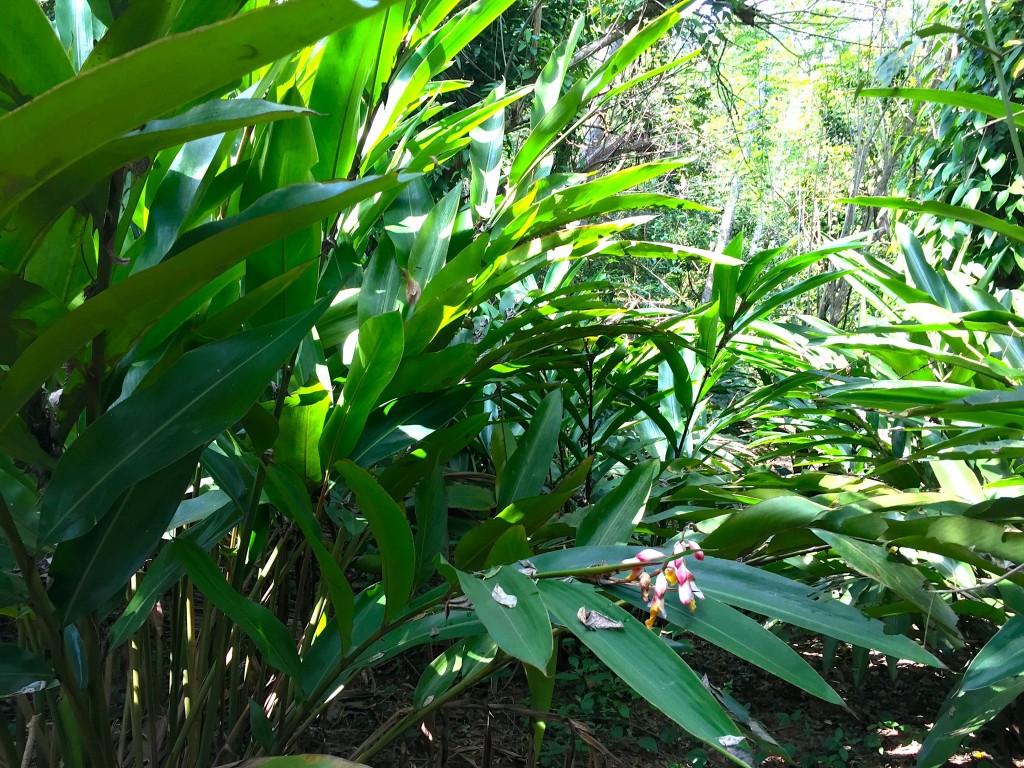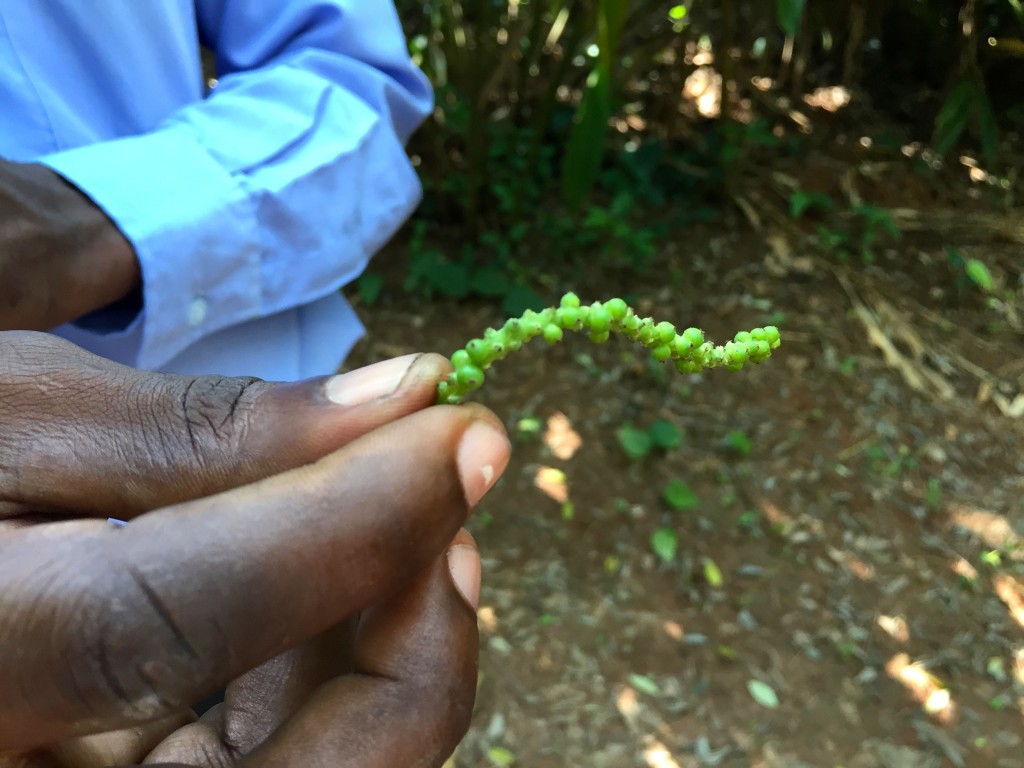The one thing I knew I wanted to see in Zanzibar was a spice plantation. I think of spices as things that come from jars that come from stores. Have you seen the clips of Jamie Oliver showing city kids fresh fruits and vegetables, while they make sadly wrong guesses? They guess that tomatoes are potatoes, an eggplant is a pear, a beet is an onion. You could think, “wow, they have no idea what real food looks like.”
Going on the spice tour though, I got to experience being that kid. Our spice tour guide, David, walked through a lush green forest, plucking this and that, handing it to us to smell and take a guess, and store in the leaf cone they made for us to collect our treasures. Being a gardener, I thought I’d do okay, but I think I flunked the test. I got off to a good start when our first off I got a whiff of lemongrass, which I’ve seen in nurseries. But too many times I had to default to “that smells like Christmas.” Would you recognize these plants?

One of the first plants that piqued my interest looked like a 12 foot tall ginger. I asked David what it was, but he wasn’t ready to just give up the answer. The clues and the dumb guesses would have to come first.

Once we’d reached an appropriate specimen, David stopped and plucked these green pods from the base of the plant. He squeezed a couple black seeds from the pulp for us to eat. They were quite aromatic and flavorful. A more avid cook with spice experience would probably recognize the pods since you can buy them whole, but I never have. I realize now it tasted familiar from Arabic Coffee. A the time I was still stumped.

David identified the plant as a cardamom. Here is further proof that common names can be confusing. David described this as the #2 cardamom, not the preferred #1 cardamom, because you have to hand pollinate this one and it comes from the root. He described a #1 cardamom coming from a flower which produces seeds without requiring hand pollination. I thought this would be something I could sort out by fact checking online once I got back home, but I remain confused.

Online I read that there are two types of cardamom. Green, which is the real, preferred cardamom which grows from Elettaria cardamomum. Then there is black cardamom, Amomum subulatum, which is smoky in flavor because it is fire dried. No mention of different pollination methods, but the foliage resembles Elettaria cardamomum. But the flowers are down around the base of the plant where the green pods are found. And this flower is pretty tall. So I am still in the territory of probably misidentifying common food, but to the best of my knowledge this was an Elettaria cardamomum.

I don’t feel quite so silly guessing that this is a ginger, since Elettaria cardamomum is in the ginger family, Zingiberaceae, which includes more than 1300 species. And, like all gingers, I want to grow it, but this one is not frost hardy. Fortunately we still have plenty of hardy gingers to choose from, if you’re not in it for the edibles.

This was another tree that stumped me at first.

They shaved off a slice of the bark and handed it over for our investigation. The smell of cinnamon was subtle, but definitely recognizable. Apparently there are many types of cinnamon trees. Cinnamomum burmannii, which is known as Indonesian or Java cinnamon. There are also Cinnamomum cassia and Cinnamomum aromaticum which are known as Chinese cinnamon, and Cinnamomum loureiroi, which is known as Vietnamese cinnamon. I haven’t had luck figuring out which one we were dealing with.

The slice of bark is the cinnamon which gets dried into the familiar cinnamon sticks we buy here. The root in front of it was dug from the base of the tree, and smells exactly like Vicks Vapor Rub, and is used as a home remedy.

Probably only a gardener would appreciate this, but I thought it was interesting to see this weird growth cropping on this leaf. David didn’t know what it was, but he said it would be dealt with by cutting it off. No pesticides are being used in this plantation. He told us this was a small co-op run by families, and larger commercial spice plantations in the area would be more inclined to use pesticides.

Here we had an unripe clove seed pod. First David crushed the leaves, which of course I thought smelled like Christmas.

Another plant we eat at damn near every meal, which looked not at all familiar to me, although I guessed correctly this time, once I saw the seed pods.

Piper nigrum, or pepper, as in “fresh ground pepper?” from which we get black, white, and green pepper, all from the same plant, using different processes. However, pink pepper comes from an entirely different plant related to the cashew, Schinus molle or Schinus terebinthifolius.

Another crop that belongs to the ginger family. Do you know this one?

The flower was stunning.

But I’m always falling in love with foliage.

I couldn’t identify it until the root was dug and cut in half, revealing bright gold turmeric.

How about this beautiful vine?

It’s an orchid that clings to a host with aerial roots.

Once I saw the pods, I figured out that this was vanilla. Vanilla planifolia is an orchid with flowers that last one day if not pollinated. Self pollination occurs only 1% of the time, so it’s hand pollinated, which partially explains its high cost. I guess drying vanilla is another labor intensive part of the process. David told us that they dry them in the stalk of a banana. It would make sense that bananas are re-used since they’re so plentiful there. I hoped to learn more about this process once I got home, but I can’t find any published details about the banana drying method.

This festive red pepper was described as a Pilipili hoho. I think this is one of those cases where the common name is too broad to be able to identify the actual plant. He said this was the hottest pepper, and you would say “ho ho” if you ate it. I didn’t try it to verify. I like some spice, but I’m not a dare-devil.


One of the plants that seems to come up on everybody’s account of a Zanzibar spice tour is the Lipstick plant, which I’m pretty sure is Bixa orellana, aka Annatto.

It seems to be a standard tourist trick for the host to split open the pod and paint on lipstick and a bindi. The pigment is surprisingly vivid and opaque. It’s quite likely part of our diet since it’s used as a commercial food coloring.


So, I was slow to recognize plants I eat all the time. How about you? Did you do better than I did identifying them at first look?
